Abstract
Purpose
To investigate the biologic effect of mitomycin C, dexamethasone and cyclosporine A 0.05% on cultured human keratocytes in vitro.
Methods
Human corneal keratocytes were exposed to a concentration of mitomycin C (0.05%), dexamethasone (0.05%) and cyclosporine A (0.05%) for a period of 3, 5, and 10 minutes. MTT-based colorimetric assay was performed to assess the metabolic activity of cellular proliferation and the concentration of type I procollagen COOH-terminal peptide (PIP) and laminin were measured. Cell damage was determined by using the lactate dehydrogenase (LDH) assay. Apoptotic response was evaluated utilizing flow cytometric analysis with Annexin V and propiodium iodide.
Results
The inhibitory effect of cellular proliferation and cytotoxicity in cultured human keratocytes showed a time-dependent response in all drugs. The production of PIP and laminin showed a time-dependent response in cultured cells. Apoptosis was observed in flow cytometry after being treated with mitomycin C, dexamethasone and cyclosporine A. Cyclosporin A resulted in less apoptosis of keratocytes than mitomycin C and dexamethasone.
Conclusions
The apoptotic response of mitomycin C, dexamethasone and cyclosporine A is associated with the inhibitory effect of human corneal keratocyte proliferation. To decrease corneal opacity, mitomycin C and dexamethasone were more effective than cyclosporine A in the present study. Additionally, a high concentration of cyclosporine A greater than 0.05% is necessary to lower corneal opacity.
Go to : 
References
1. Salomao MQ, Wilson SE. Corneal molecular and cellular biology update for the refractive surgeon. J Refract Surg. 2009; 25:459–66.

2. Nishida T, Yasumoto K, Otori T, Desaki J. The network structure of corneal fibroblasts in the rat as revealed by scanning electron microscopy. Invest Ophthalmol Vis Sci. 1988; 29:1887–90.
3. Bergman RH, Spigelman AV. The role of fibroblast inhibitors on corneal healing following photorefractive keratectomy with 193-nanometer excimer laser in rabbits. Ophthalmic Surg. 1994; 25:170–4.

4. Gartry DS, Muir MG, Lohmann CP, Marshall J. The effect of topical corticosteroids on refractive outcome and corneal haze after photorefractive keratectomy: A prospective, randomized, double blind trial. Arch Ophthalmol. 1992; 110:944–52.
5. de Benito-Llopis L, Teus MA, Sánchez-Pina JM. Comparison between LASEK with mitomycin C and LASIK for the correction of myopia of −7.00 to −13.75 D. J Refract Surg. 2008; 24:516–23.
6. Carones F, Vigo L, Scandola E, Vacchini L. Evaluation of the prophylactic use of mitomycin-C to inhibit haze formation after photorefractive keratectomy. J Cataract Refract Surg. 2002; 28:2088–95.

7. Ursea R, Purcell TL, Tan BU, et al. The effect of cyclosporine A (Restasis) on recovery of visual acuity following LASIK. J Refract Surg. 2008; 24:473–6.

8. Tani E, Katakami C, Negi A. Effects of various eye drops on corneal wound healing after superficial keratectomy in rabbits. Jpn J Ophthalmol. 2002; 46:488–95.

9. Sher NA, Chen V, Bowers RA, et al. The use of the 193 nm excimer laser for myopic photorefractive keratectomy in sighted eyes. A multicenter study. Arch Ophthalmol. 1991; 109:1525–30.
10. Carones F, Brancato R, Venturi E, et al. Efficacy of corticosteroids in reversing regression after myopic photorefractive keratectomy. Refract Corneal Surg. 1993; 9:S52–6.

11. Obrart DP, Lohmann CP, Klonos G, et al. The effects of topical corticosteroids and plasmin inhibitors on refractive outcome, haze and visual performance after photorefractive keratectomy; A prospective, randomized observer-masked study. Ophthalmology. 1994; 101:1565–74.
12. Stevenson D, Tauber J, Reis BL. Efficacy and safety of cyclosporin A ophthalmic emulsion in the treatment of moderate-to-severe dry eye disease: a dose-ranging, randomized trial. The Cyclosporin A Phase 2 Study Group. Ophthalmology. 2000; 107:967–74.
13. BenEzra D, Maftzir G. Ocular penetration of cyclosporin A: the rabbit eye. Invest Ophthalmol Vis Sci. 1990; 31:1362–6.
14. Lee JE, Shin WB, Lee JS. Effect of cyclosporine A 0.05% on human corneal epithelial cells. J Korean Ophthalmol Soc. 2007; 48:1399–409.

15. Hingorani M, Calder VL, Buckley RJ, Lightman S. The immunomodulatory effect of topical cyclosporine A in atopic keratoconjunctivitis. Invest Ophthalmol Vis Sci. 1999; 40:392–9.
16. Soya K, Obata H, Amano S, et al. Effects of topical corticosteroids on subepithelial haze after excimer laser corneal surgery-objective and quantitative method for evaluationg haze. Nippon Ganka Gakkai Zasshi. 1997; 101:152–7.
17. Furukawa H, Nakayasu K, Gotoh T, et al. Effect of topical tranilast and corticosteroids on subepithelial haze after photorefractive keratectomy in rabbits. J Refract Surg. 1997; 13:s457–8.

18. Argento C, Cosentino MJ, Ganly M. Comparison of laser epithelial keratomileusis with and without the use of mitomycin C. J Refract Surg. 2006; 22:782–6.

19. Okamoto S, Sakai T, Iwaki Y, et al. Effects of tranilast on cultured rabbit corneal keratocytes and corneal haze after photorefractive keratectomy. Jpn J Ophthalmol. 1999; 43:355–62.

20. Lai YH, Wang HZ, Lin CP, Chang SJ. Mitomycin C alters corneal stromal wound healing and corneal haze in rabbits after argon-flu-oride excimer laser photorefractive keratectomy. J Ocul Pharmacol Ther. 2004; 20:129–38.

21. Lee JE, Lee JS. Inhibitory effect of mitomycin C(MMC) on the proliferation of human corneal keratocyte. J Korean Ophthalmol Soc. 2002; 43:2519–26.
22. Netto MV, Mohan RR, Sinha S, et al. Effect of prophylactic and therapeutic mitomycin C on corneal apoptosis, cellular proliferation, haze, and long-term keratocyte density in rabbits. J Refract Surg. 2006; 22:562–74.

23. Lee JE, Lee SU, Kim JH, Lee JS. Effect of dexamethasone and diclofenac on the proliferation of human corneal keratocytes. J Korean Ophthalmol Soc. 2005; 46:133–43.
Go to : 
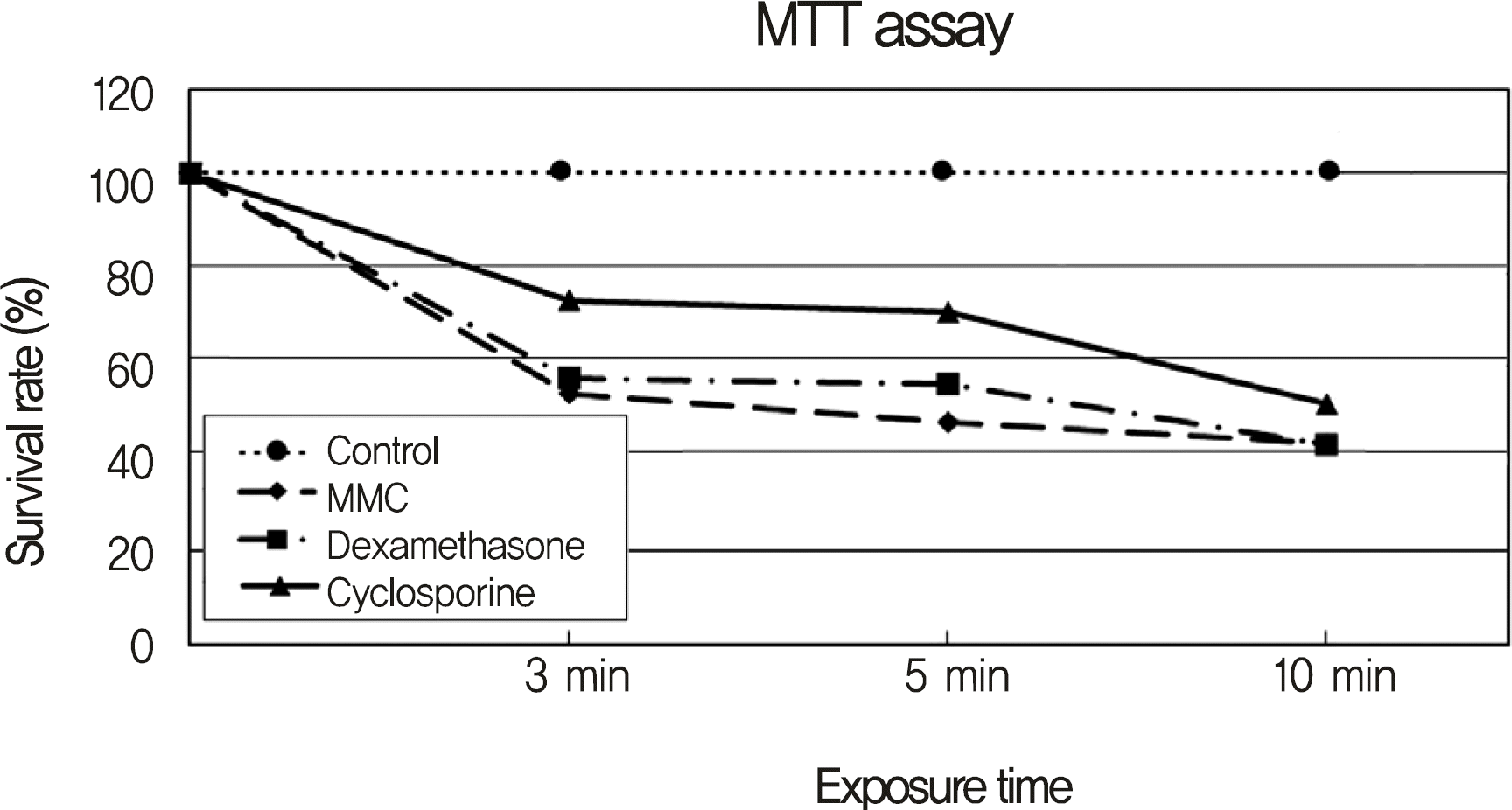 | Figure 1.The absorption rate of the water-insolubale formazan dye in cultured human keratocytes exposed in the four eye drops by a scanning spectrometer (ELISA reader). The longer the exposure duration, the more decreased the metabolic activity of keratocytes in all drugs. After 10 minutes of exposure, the metabolic activity of keratocytes in all drugs was decreased more significantly than control (p = 0.03). Mytomicin-C (MMC) showed most prominent inhibitory effect for cellular metabolic activity, and cyclosporine showed minimal inhibitory effect, but the values were not statistically significant. |
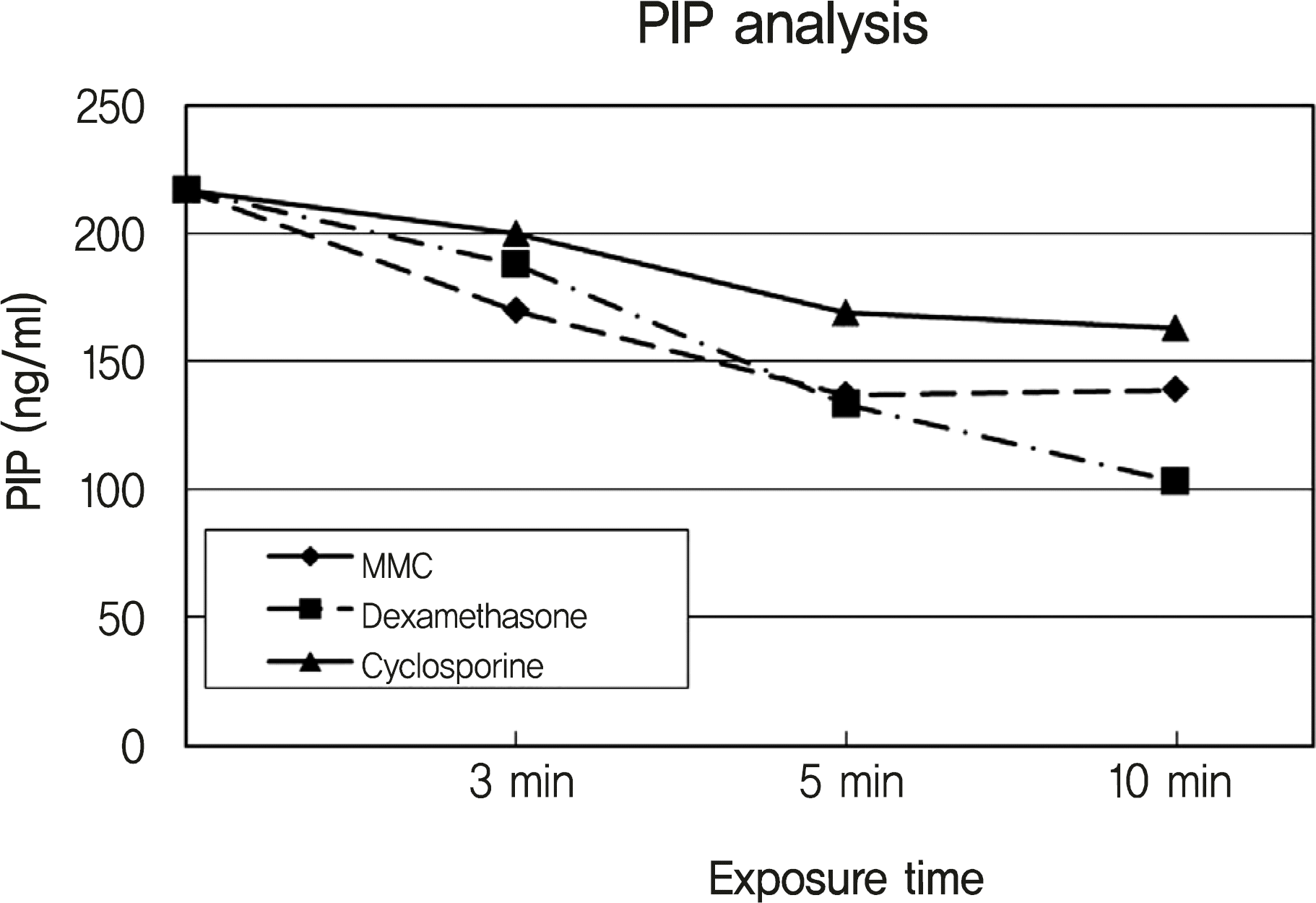 | Figure 2.PIP titers of cultured human keratocytes in three eye drops. The concentration of PIP was decreased, the longer the exposure duration in all drugs. Mytomicin-C (MMC) and dexamethasone showed more prominent inhibitory effect for PIP level than cyclosporine, but the values were not statistically significant. PIP = procollagen type I COOH-terminal peptide. |
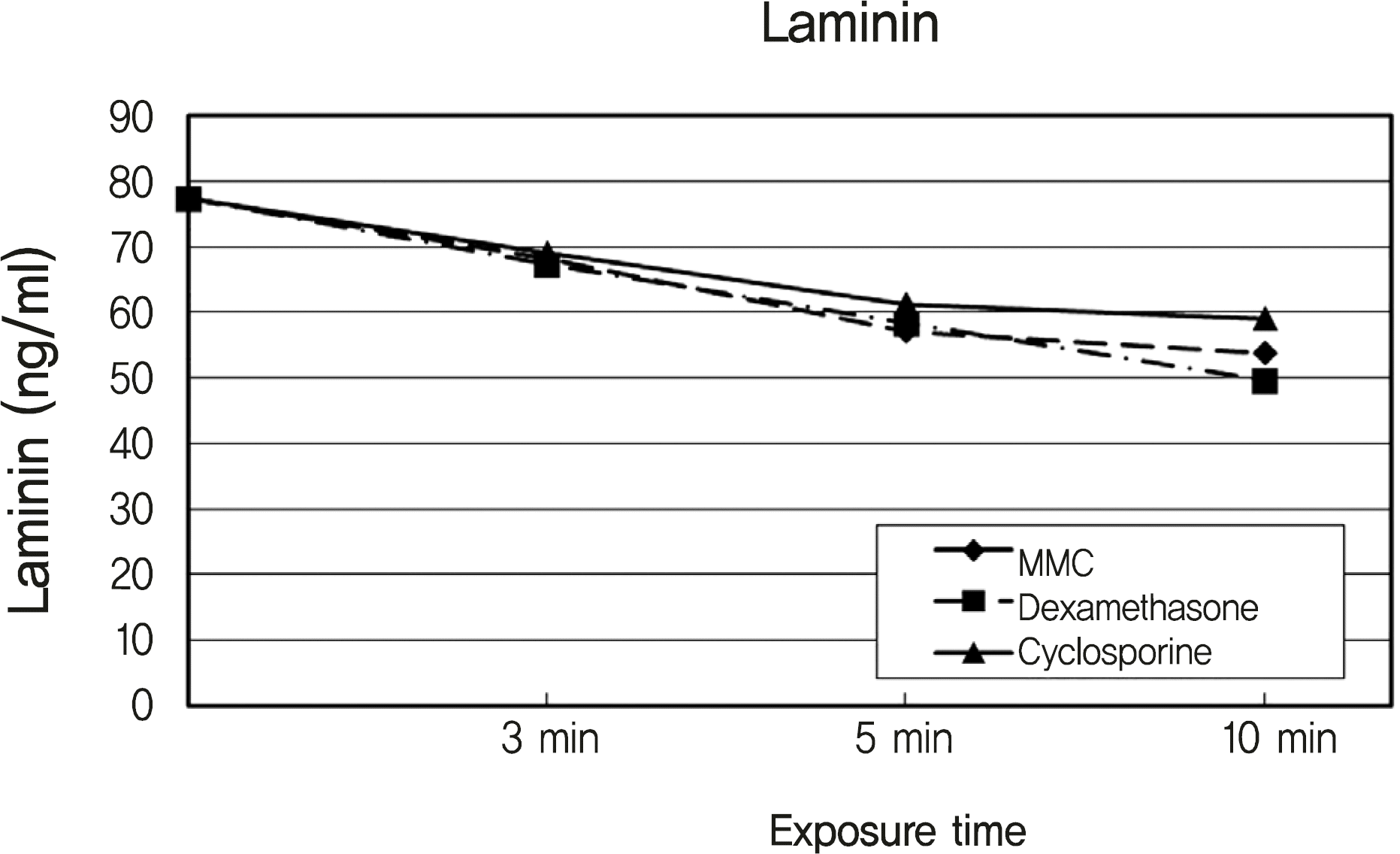 | Figure 3.Laminin titers of cultured human keratocytes exposed in three eye drops, Mytomicin-C (MMC), dexamethasone and cyclosporine. The concentration of laminin was decreased, the longer the exposure time in all drugs. MMC and dexamethasone showed more prominent inhibitory effect for PIP level than cyclosporine, but the values were not statistically significant. PIP = procollagen type I COOH-terminal peptide. |
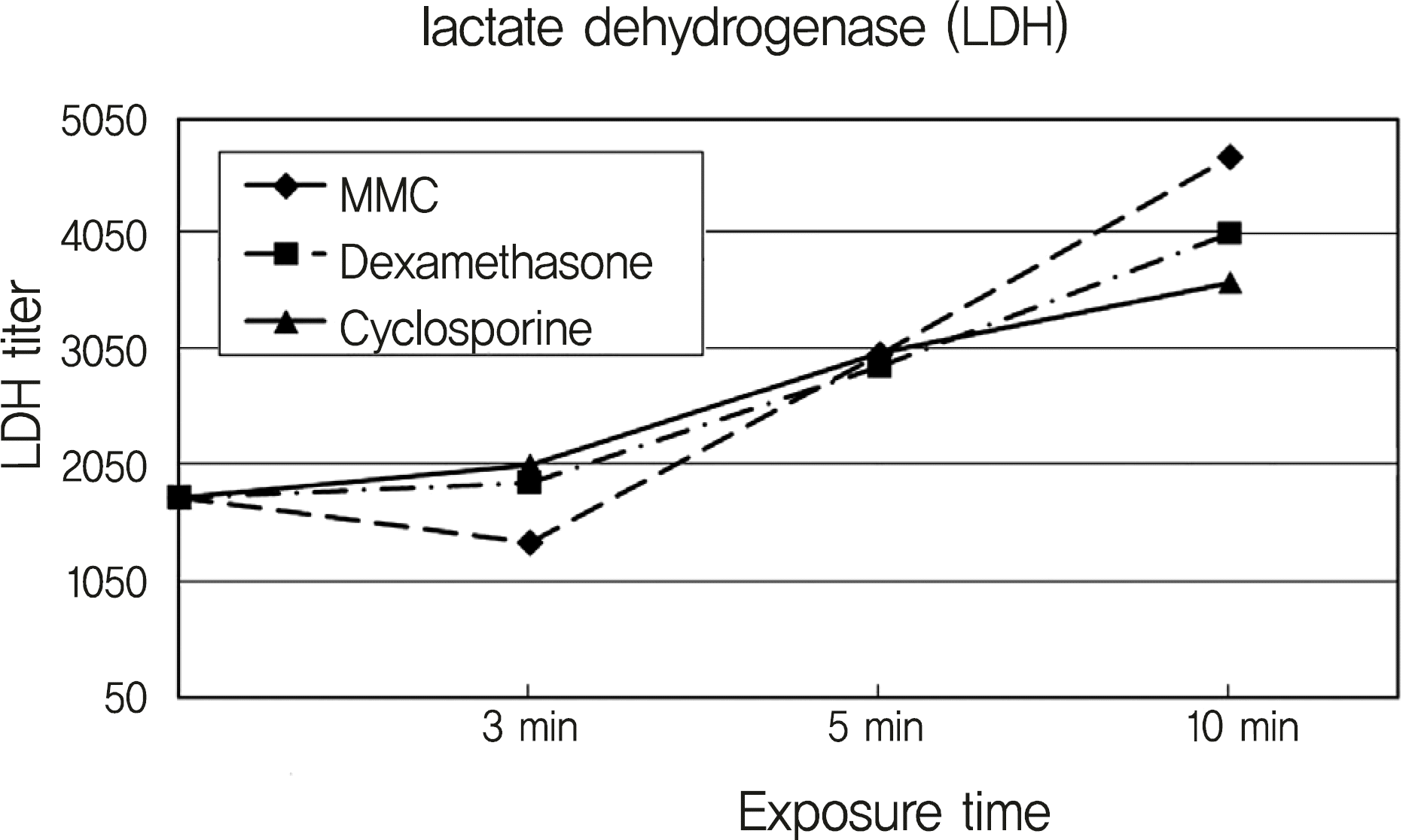 | Figure 4.LDH activity of cultured human keratocytes exposed in three eye drops, mitomycin-C (0.05%), dexamethasone (0.05%) and cyclosporine A (0.05%). The lactate dehydrogenase (LDH) titers of cultured human keratocytes showed a kind of time dependent response. The LDH titers of MMC and dexamethasone were higher values than that of cyclosporine at 10 minutues, but the values were not statistically significant. MMC = mitomycin-C. |
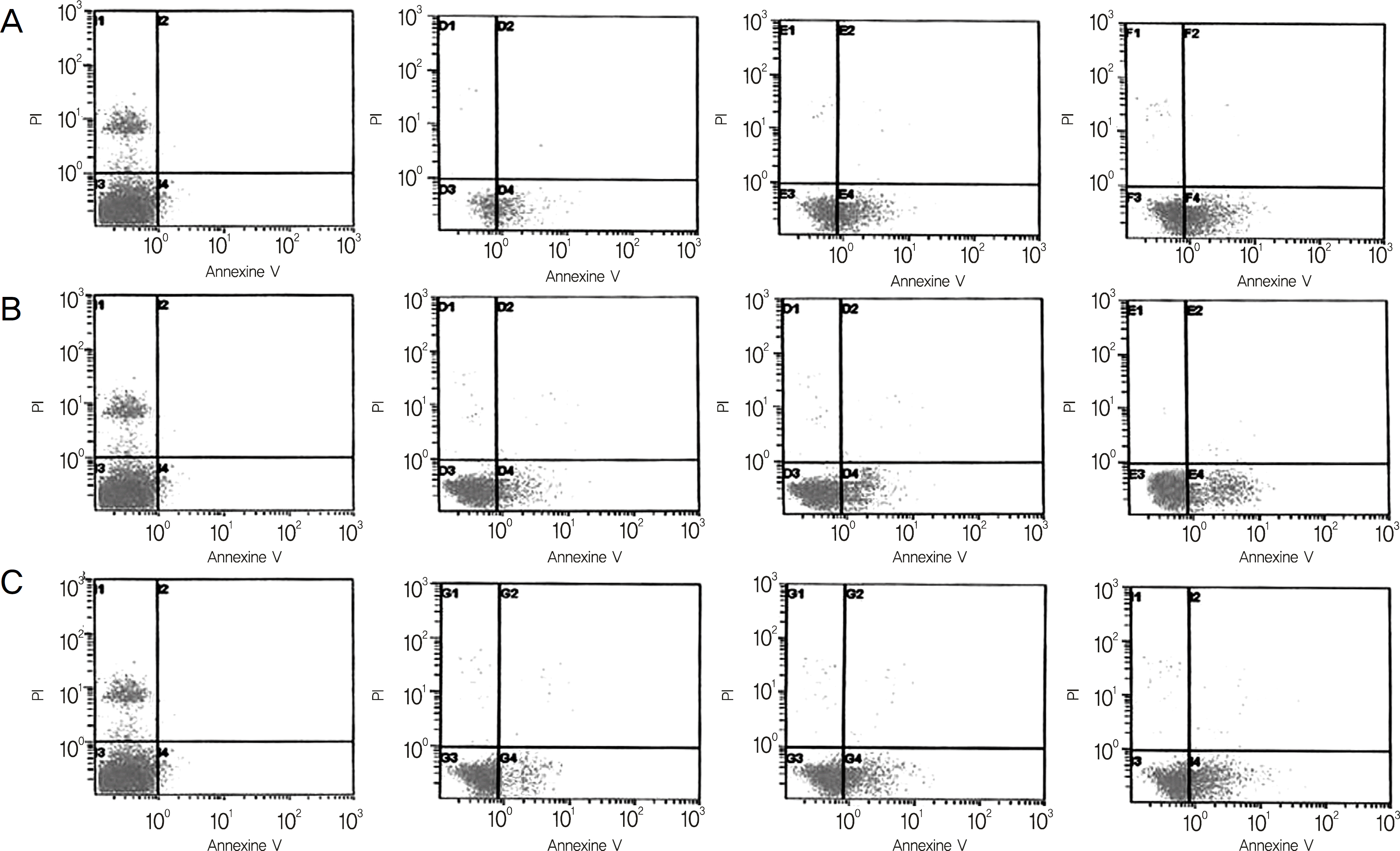 | Figure 5.Flow cytometric analysis of apoptotic cells using Annexin V FITC after being treated treating with MMC (A), dexamethasone (B) and cyclosporine A (C). In all cases, apoptosis showed a time-dependent response. Cyclosporine A results in less apoptosis of keartocyte than dexamethasone and MMC. MMC = mitomycin-C; FITC = fluorescein isothiocyanate. |




 PDF
PDF ePub
ePub Citation
Citation Print
Print


 XML Download
XML Download